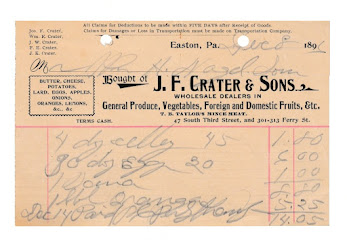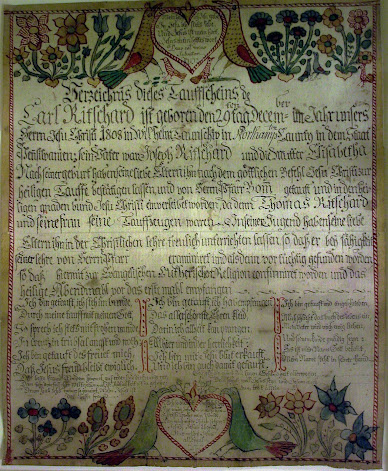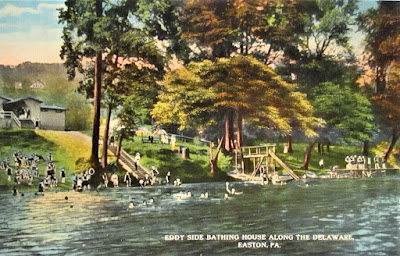Where's Joe?
By Rory Morgan
In Easton Cemetery's Section Q, there is large family marker that reads "Crater". It is surrounded by numerous smaller markers, each memorializing an individual family member. In one of history's strange twists, there is no marker for the one family member who went down in history.
The story of the Crater family in Easton began with Joseph Force "Pa" Crater. Born in New Jersey in 1829, he and a partner operated a produce business in Hackettstown, NJ. but Pa decided that the business prospects were better in Pennsylvania. So, he moved his family across the Delaware to Easton. He began there as a huckster (one who sells produce from a cart or stand), but eventually opened a wholesale produce business that carried his name: Joseph F. Crater and Sons. It was located at the corner of Third and Ferry, which came to be known as Crater’s Corner. (A city parking lot now stands there.)
The family owned two peach orchards in New Jersey and others in the northern parts of the Northampton County. When the peaches were ready to harvest, a number of Lafayette College students were hired to pick. The Craters also owned cold storage facility described as being "back of the Fifth Street Catholic Church property". In the winter, ice was cut from the river bu mules up the steep hill to the cold storage building.
Pa married Catherine Everett, an Easton woman; they went on to have four sons. One of the those sons was Frank, born in 1863. He married Leila Virginia Montague, part of a well-established Easton family. The couple had four children: Joseph, Margaret, Douglass and Montague.
Joe was the oldest of the children. He graduated from Easton High School in 1906 (the first time that caps and gowns were worn for Easton's graduation ceremony). His academic standing was one of the two highest in the class and he was Class President for two years. His activities included working on the yearbook and membership in the Mandolin Club. A tongue-in-cheek biography in the yearbook talked of his extraordinary vocabulary, his gaudy neckties, his interest in the opposite sex and his ability to “bluff” his teachers. In a foreshadowing of the future, in 1905, when Joe was President of the Junior Class, he was "kidnapped" by members of the Senior Class and locked up for a few hours. In his senior year, by vote of the high school faculty, Joe was awarded the annual scholarship to Lafayette College. While at Lafayette, he joined the Sigma Chi fraternity and carried its tattoo for the rest of his life.
Following Lafayette, he went to law school at Columbia University in New York City, graduating in 1913. In 1912, while still a law student, he met a woman named Stella Mance Wheeler; he helped her with her divorce. A few years later, Stella became Mrs. Crater.
Joe set up a legal practice in the city, taking on a variety of cases. He worked as a law clerk and also taught in several of New York's law schools. He began to rub elbows with those who had political connections. Joe saw these connections as important keys in building a successful legal practice. The Democratic political machine in New York City, Tammany Hall, was vast and corrupt. It generated an ocean of legal business; more and more of which found its way to Joe's desk. He handled the work well (there was never a question about his competence as a lawyer) and it was lucrative. He became the confidential secretary and clerk to Robert Wagner, a prominent judge who would later become a U.S. Senator.
He and his wife Stella bought a luxurious home on Fifth Avenue and a vacation home in Maine. They bought a Cadillac and hired a chauffeur (Joe had never learned how to drive.) He became an avid theater-goer and was a regular at the various night spots in the Broadway area. He drank very little, but still established a reputation as a Good Time Joe, who enjoyed the company of some of the very single actresses and dancers who were part of the Broadway scene. Meanwhile, Stella stayed home with their cat.
In April of 1930 there was a temporary opening for a judge on New York’s Supreme Court. (Despite its name, the New York the Supreme Court was - and still is - a county-level court, not the highest court in the state.) Governor Franklin D. Roosevelt wasn't part of the Tammany crowd, but he was influenced by it. He appointed Crater to fill the position for a few months, with the expectation that he would run for a full 14-year term in the upcoming November election. Of course, Tammany expected its usual payment for an appointment: one-year’s salary - about $22,000 - paid in cash at the time of the appointment.
The dog-days of August, 1930, brought their usual heat and humidity to Manhattan.The legal world slowed to a crawl as lawyers and judges alike left the city for cooler places. Joe had only a handful of cases assigned to him; he had been a judge for just a few months.
Stella Crater was spending the summer at the Maine home; Joe took the train between New York and Maine - the Bar Harbor Express - as necessary. Earlier that summer, Joe and a couple of male friends took a trip to Atlantic City; they were accompanied by three or four women, none of whom were their wives
When August 6, 1930 rolled around, Joe was in the city. He spent part of the day in his office behind closed doors, pulling documents from his files. He packed them up and, with the assistance of his law clerk, took them to his home. (No one knows where those files ended up.) He also cashed checks for several thousand dollars. In the evening, he went to a restaurant on West 45th Street, where he encountered two friends. They invited Joe to join them for dinner. After a pleasant meal, the three of them left the restaurant. Joe was never seen again, dead or alive, by any credible witness.
He had promised Stella that he would be back in Maine by August 9 for her birthday. When he failed to appear by then, an informal investigation began. When Joe didn’t show up for the opening of his court cases on August 25, his absence finally became public knowledge and exploded into the headlines. An official “Missing Person” report was filed with the police. The NYPD began to circulate “missing person” posters. Ultimately, about 100,000 were printed. A reward of $5,000 was offered.
A Grand Jury was called to investigate, but it reached no conclusions, despite hearing testimony from nearly 100 people. Unfortunately, many of the statements from witnesses were confused and contradictory. Not even his two dinner companions could say for sure whether Joe got into a cab or whether he walked away from the restaurant. He was supposedly going to see a play that night, at the Belasco Theater, only a couple of blocks from the restaurant. West 45th was a one-way street; traffic, including taxis, would have been running away from the Belasco. Considering that taxis at that time were not air-conditioned, riding in one could been been quite uncomfortable. It would have made more sense for Joe to just walk.
Whatever the reason, a judge was missing; an investigation was required. A generous reward was offered. An unidentified body that had been pulled from the river near Martin's Creek a few weeks earlier was exhumed; a couple of Crater's long-time friends were called to identify the body. They pointed out that the body had natural teeth; Crater wore false upper teeth. They also pointed out that the body didn't have the fraternity tattoo which Crater was known to have. Their final point: the unidentified body was wearing cheap underwear; Crater's taste in clothing would have insured that he would wear finer fabric.
Thousands of “sightings” came into the New York City police and continued to do so for years. Most of them were ludicrous or incoherent. He was supposedly "seen" prospecting for gold in the West. He was "seen" running a bingo game in Africa. More than 20 years after his disappearance, a yard in Yonkers, NY was dug up, based on the supposed visions of a psychic in Holland. Unsurprisingly, no trace of Joe or any other person was found.
Theories abounded. Gangland murder was a popular one - perhaps mobsters were angry with Joe about how he handled some legal situation. Another theory held that Joe died after he suffered a fatal medical emergency while visiting a “house of ill repute'' and his body was surreptitiously destroyed. Reform-minded officials in New York had started, at last, to investigate some of the corruption that was practiced by Tammany, including the selling of judgeships. Did Joe suspect that he would soon be under scrutiny, and take off, one step ahead of the law?
Stella was evicted from her New York home in 1938. She worked as a telephone operator for a while but was fired when her identity became known. She didn’t have nearly enough money to support herself for the rest of her life. Joe had left her a note, one found under strange circumstances, which listed a number of people who Joe believed owed him money. Joe apparently had faith that they would honor their debts to him. Supposedly, some did, but others just ignored the situation; they claimed that they didn’t owe him money.
In 1939, the authorities finally ruled that Joe was legally dead, which gave Stella access to a modest amount of money from his life insurance.
Stella wrote a book in 1961 about her life with Joe: The Empty Robe. In it, she portrayed him as a loving husband who would never be unfaithful and wanted nothing more than to sit by the fire and sing old songs. According to her, the story behind his disappearance was simple. It was political. Joe simply knew too much about what went on in the Tammany-infested city. Besides, her Joe would never be involved in something questionable! Stella eventually went to a nursing home and died there in 1969.
As for Joe - well, no trace of him has ever been found. In 2005, there was a flurry of excitement following the death of an elderly widow in Queens. Some papers in her possession revealed a story that her late husband had heard, about a supposed plot to kill Crater and bury him at Coney Island. The NYPD didn’t believe that there was enough evidence to reopen a 75-year old case. Meanwhile, at the Easton Cemetery, you will see no individual stone for Joe - but if you walk around to the back of the Crater family monument you’ll see this carved into the stone: “In memory of Joseph F Crater II”. He was once the pride of Easton; but as they say, "Sic transit gloria mundi."
Author’s Note: There are several books, both fiction and non-fiction, related to Judge Crater’s story. Three of them - all nonfiction - are held at the Easton Area Public Library. They are The Empty Robe by Stella Crater, (Marx Room Collection), and Finding Judge Crater, by Stephen J. Riegel, (Marx Room Collection) and Vanishing Point, by Richard J. Tofel (Main Collection).
 |
Crater's Corner @ Third and Ferry. This photo was taken after "Pa" Crater's death.
When he died, the business name was changed to "Joseph F. Crater's Sons"
|
 |
Crater family monument
|
The rear of the Crater monument
Stella Crater

















